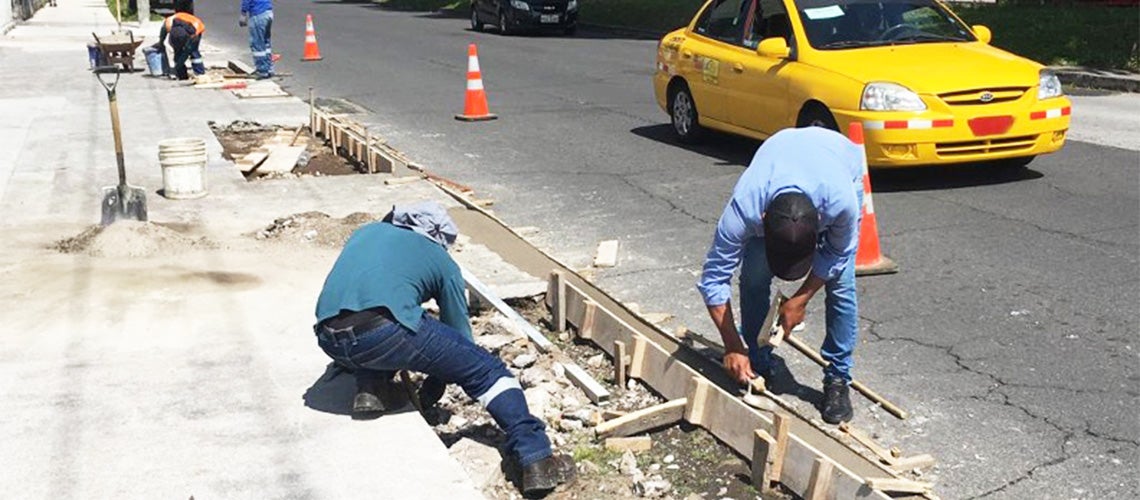 Construction of sidewalks in Quito, Ecuador
Construction of sidewalks in Quito, Ecuador
Did you know that metro systems are some of the safest transport modes?
In the USA, it is 30 times more dangerous to travel by car than by urban train. And did you know that metros can contribute to road safety in cities? Whether you knew that or not, the following facts will interest you, especially if you are a resident of Ecuador´s capital, Quito.
During the last years, road traffic injuries have become the third cause of death in Quito, as per the 2020 Quito Road Safety Yearbook, higher than other causes including cancer. Around 200 people die every year in this city due to road crashes, with pedestrians being the largest victim group, many of which will be accessing the metro on foot.
The Quito metro project, financed jointly by the World Bank, the Latin American Development Bank (CAF), the European Investment Bank (EIB), and the Inter-American Development Bank (IADB), is set to begin operations in the upcoming months, serving an estimated demand of over 200 thousand passengers per day. The project will help users save time, improve air quality in the city and reduce greenhouse gas emissions.
With support from the Korean World Bank Partnership Facility (KWPF) and Bloomberg Philanthropies through the World Bank’s Global Road Safety Facility, a series of analyses were conducted following best practices, including the Road Safety Transit Oriented Development (TOD) Toolkit, to diagnose and propose solutions for road safety in Quito.
Five key lessons from this analysis are:
- Improving street design to ensure the safety of vulnerable road users. A road safety inspection of the main pedestrian access routes to 15 metro stations showed that simple, low-cost interventions to improve safety of pedestrian crossings, quality of footpaths, and reducing vehicle speeds through road design would greatly improve pedestrian safety, not only for those accessing the metro stations but for all pedestrians and other vulnerable road users in the city.
- Protecting children through safe school zones is key. Six percent of road traffic victims are under the age of 18. An analysis of school areas around the Quito metro to provide safe accessing through public transport found that high speeds were a key risk for pedestrians, especially for children. A strategy to improve school areas, by improving street design to ensure vehicle speeds are managed, would result in safer school environments. Low-cost interventions would allow:
- Minimizing the exposure of school children to vehicular traffic.
- Reducing the speed of vehicles by applying safer speed limits and implementing traffic calming measures.
- Improving sidewalks, creating safer pedestrian crossings, and removing any obstacles (including vehicles parked) to increase visibility among vehicle drivers and students.
- Prioritizing speed management. Speed is the main cause of road crashes, identified in at least 30% of urban and regional crashes in the country. A strategy to manage speed, by setting safe speed limits for all roads in Quito is a key starting point to achieve significant reduction in road trauma. A pilot on speed management conducted in two conflictive spots in Quito with recurrent speeding problems (Mariscal Sucre and Simon Bolivar) showed inconsistent speed limits within the same road segment -specially in high-volume ones as these two- and a lack of signaling. This means that users do not know exactly how fast they can circulate in some of the city roads, which incentivizes speeding on roads that are designed for high speeds.
- Automating speed enforcement can yield significant benefits in a short time frame. The pilot project on speed enforcement also showed that compliance with speed limits can be achieved. International experience shows that automated speed enforcement can reduce fatalities and serious injuries between 11% and 44%, especially if this is done in combination with better road signaling and with communication and awareness campaigns.
- Institutional coordination with the aim of working together to achieve road safety objectives is required for all agencies in charge of planning, designing, building, and operating transport infrastructure. The improvement of road safety measures ultimately requires increased political will and commitment at the highest level of government. Good quality data is also key to fine tune road safety policies, target speed management measures, and evaluate project success.
Metro projects are an opportunity to improve road safety and introduce new measures, such as infrastructure improvement or even policy actions. Quito metro will not only have state-of-the-art technology in its tunnels and rolling stock but will also provide safe access routes to pedestrians and other vulnerable road users, bringing economic benefits and shared prosperity to the inhabitants of Quito.



Join the Conversation